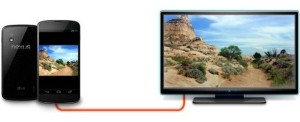Last week we discussed how consumers are using DisplayPort for a multiple monitor experience in both productivity and PC gaming use cases. This week we are highlighting some more reasons to use DisplayPort.
- Streaming from the small screen to the big screen
More people are using mobile devices to share and consume content. With Mobility DisplayPort (MyDP) standard, users are able to connect their phone and stream content to a DisplayPort-enabled monitor. MyDP standard allows high-quality audio, video, and 3D content to be shared from a mobile device to a larger external DisplayPort or HDMI equipped display, including a PC monitor, digital signage display or HDTV. By leveraging a simple passive cable, consumers can instantly experience their content at 1080p full HD resolution, 24-bit color, and 60Hz. MyDP also enables charging of the mobile device battery from the power provided by the DisplayPort-enabled display, while content is enjoyed. Users can also access the millions of legacy DVI and VGA displays, projectors and TVs through the use of MyDP adaptors and active converters.
- Legacy interface compatibility
It would be nice to be always equipped with the latest and greatest technology, however sometimes our budget isn’t that accommodating. Technology often moves at light speed which often results in new interface connectors before consumers are ready with upgraded peripherals. Upgrading all of your equipment can be expensive and time consuming. To help users through the DisplayPort adoption transition, DisplayPort has been designed to be backward compatible with legacy display interfaces. DisplayPort adapters allow consumers to upgrade to DisplayPort-ready personal computers without having to replace their current DVI, VGA or HDMI displays. DisplayPort adapters thus allow users to “future proof” their next system until later upgrading to higher performance DisplayPort-enabled displays.
Do you have DisplayPort-enabled products? If so, how else do you use DisplayPort? Share with us in the comment section below.

